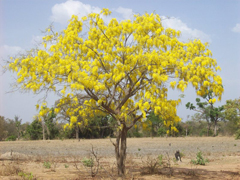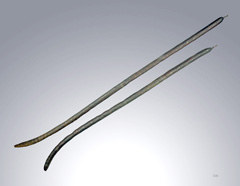 |
|
© Oumarou Quédraogo |
 |
| Didier Descouens wikimedia.org |
Translate this page:
Summary
West African Laburnum, Cassia sieberiana, is a tropical, deciduous small tree of about 10-20 m tall with dark grey and wrinkled bark. It is characterized by its bright yellow and attractive flowers that form into groups and are upright or hanging. The plant has several medicinal functions. It is used as a purgative and diuretic. When powdered, different plant parts is used as relief from toothache; and for skin diseases when mixed with butter. Stomach pains, ulcers, diarrhoea, malaria, fever, burns gonorrhoea, etc. can also be treated using different forms of different plant parts of West African laburnum. The wood of the roots is used as chewsticks and the wood as material in making furniture or as construction material, and for fuel.
Physical Characteristics

 Cassia sieberiana is a deciduous Tree growing to 15 m (49ft) by 15 m (49ft) at a medium rate.
Cassia sieberiana is a deciduous Tree growing to 15 m (49ft) by 15 m (49ft) at a medium rate.
See above for USDA hardiness. It is hardy to UK zone 10. The flowers are pollinated by Insects.
It can fix Nitrogen.
Suitable for: light (sandy), medium (loamy) and heavy (clay) soils and prefers well-drained soil. Suitable pH: mildly acid, neutral and basic (mildly alkaline) soils and can grow in very acid soils.
It cannot grow in the shade. It prefers dry or moist soil.
UK Hardiness Map
US Hardiness Map
Synonyms
Cassia kotschyana Oliv.
Plant Habitats
Edible Uses
Edible Parts: Leaves Stem
Edible Uses:
Edible portion: Leaves, Stems. The sweet extract from the stems is eaten. Chew sticks can also be made from the root-wood part of the plant.
References More on Edible Uses
Medicinal Uses
Plants For A Future can not take any responsibility for any adverse effects from the use of plants. Always seek advice from a professional before using a plant medicinally.
Antibacterial Antidiarrhoeal Antihaemorrhoidal Antiinflammatory Antiviral Diuretic Dysentery Febrifuge
Laxative Leprosy Malaria Odontalgic Parasiticide Poultice Purgative
Skin
The leaves, roots and pods are widely used in traditional medicine[ 299 ]. There has been some research into the medically active substances in the plant and several compounds have been identified including calcium oxalate, flavones), an anthraquinone and tannins[ 299 ]. The purgative action of the plant can be ascribed to the anthraquinones. The flavones cause diuresis and have antibacterial and anti-inflammatory activity. An assay for antiviral activity against Herpes simplex virus type 1 showed that extracts had a significant activity against this virus[ 299 ]. Leaf extracts were found to be active against Staphylococcus lutea, Mycobacterium phlei, Bacillus subtilis and Proteus sp., but not against Staphylococcus albus, Pseudomonas aeruginosa or Escherichia coli[ 299 ]. The entire plant is purgative and diuretic. An infusion is given against all children?s diseases[ 299 ]. Powder of different plant parts is applied to teeth to cure toothache; when mixed with butter it is used to treat skin diseases[ 299 ]. An infusion of the leaves sweetened with honey is taken against stomach-ache, ulcers and diarrhoea[ 299 ]. A steam bath of leafy twigs boiled in water is prescribed to help against malaria attacks and fever; the liquid should also be drunk[ 299 ]. Boiled and squeezed fresh leaves are applied as poultice in pleurisy or burns[ 299 ]. Gonorrhoea in women is treated by taking leaf powder with food[ 299 ]. The twigs are used to treat sleeping sickness[ 299 ]. The roots, boiled in water, are used to treat haemorrhoids, bilharzia, leprosy, dropsy and bloody dysentery[ 299 ]. In large doses it is used to treat intestinal worms including tapeworms, although this is risky[ 299 ]. A pinch of powdered dried decorticated roots, taken at the end of each meal, is said to prevent malaria[ 299 ]. After soaking the roots in water, the liquid is used for a bath against tiredness and for body massage[ 299 ]. Crushed roots are rubbed on the temples to treat headache[ 299 ]. An infusion of the root bark is employed against venereal diseases, sterility and dysmenorrhoea[ 299 ]. Capsules made from the root bark are prescribed against Aids[ 299 ]. The yellow pulp around the seeds and an infusion of the pods is taken as a laxative[ 299 ].
References More on Medicinal Uses
The Bookshop: Edible Plant Books
Our Latest books on Perennial Plants For Food Forests and Permaculture Gardens in paperback or digital formats.

Edible Tropical Plants
Food Forest Plants for Hotter Conditions: 250+ Plants For Tropical Food Forests & Permaculture Gardens.
More

Edible Temperate Plants
Plants for Your Food Forest: 500 Plants for Temperate Food Forests & Permaculture Gardens.
More

More Books
PFAF have eight books available in paperback and digital formats. Browse the shop for more information.
Shop Now
Other Uses
Parasiticide Teeth
Other uses rating: Low (2/5). An ornamental tree with brightly colored attractive flowers. Agroforestry Uses: The tree is sometimes planted in shelterbelts[ 774 ]. Other Uses: The root wood is used as chewsticks[ 299 ]. The heartwood is white or yellowish-pinkish, darkening to dark red upon exposure. It is finely textured, heavy, very hard, resistant to termites and difficult to work[ 299 , 774 ]. It is suitable for making furniture, cabinet work, tools, construction and railway sleepers[ 299 , 774 ]. The wood is used for fuel, but it is considered inferior because it produces a lot of smoke[ 299 ].
Special Uses
References More on Other Uses
Cultivation details
A tropical plant. A plant of drier areas of the tropics, thriving best in savannah areas with an annual rainfall of 800mm or less[ 299 ]. Prefers a deep, well-drained, moderately fertile sandy loam and a position in full sun[ 200 ]. Plants grow best in an acid, sandy soil[ 299 ]. The plant responds well to coppicing[ 774 ]. The tree is one of the constituents of the vegetation of fallow fields in the Sahel, but unlike some species, such as the African locust bean (Parkia biglobosa), and shea butter tree (Vitellaria paradoxa), it is eradicated during clearing[ 299 ]. Although it is a legume, the roots of this species lack nodulating ability and do not fix atmospheric nitrogen[ 299 ].
References Carbon Farming Information and Carbon Sequestration Information
Temperature Converter
Type a value in the Celsius field to convert the value to Fahrenheit:
Fahrenheit:
The PFAF Bookshop
Plants For A Future have a number of books available in paperback and digital form. Book titles include Edible Plants, Edible Perennials, Edible Trees,Edible Shrubs, Woodland Gardening, and Temperate Food Forest Plants. Our new book is Food Forest Plants For Hotter Conditions (Tropical and Sub-Tropical).
Shop Now
Plant Propagation
Seed - when fresh seed is sown there is almost 100% germination[ 299 ]. Older seed needs to be treated before sowing by soaking in warm water for 12 - 24 hours or by sulphuric acid stratification[ 299 ]. Passage of seeds through cattle intestines also hastens germination[ 299 ]. Marcotting and side-grafting are feasible for vegetative multiplication.
Other Names
If available other names are mentioned here
West African Laburnum, Cassia sieberiana. Other Names: Bentape, Betame, Bissindje, Bussindja, Canafistra, Canafistula, Caquecequece, Kiskatigrai, Marga, N'tame, P'fonante, Sama-sidjam, Samba-cintrao, Samba-sinhangho, Samba-sinjandje, Sambassinhague, Sambassinhame, Sambisinhanha, Sandjone, Sanfone, Sanjoue, Sindjam-o, Untame.
Native Range
Coming Soon
Weed Potential
Right plant wrong place. We are currently updating this section.
Please note that a plant may be invasive in one area but may not in your area so it's worth checking.
None Known
Conservation Status
IUCN Red List of Threatened Plants Status : This taxon has not yet been assessed.

Growth: S = slow M = medium F = fast. Soil: L = light (sandy) M = medium H = heavy (clay). pH: A = acid N = neutral B = basic (alkaline). Shade: F = full shade S = semi-shade N = no shade. Moisture: D = dry M = Moist We = wet Wa = water.
Now available:
Food Forest Plants for Mediterranean Conditions
350+ Perennial Plants For Mediterranean and Drier Food Forests and Permaculture Gardens.
[Paperback and eBook]
This is the third in Plants For A Future's series of plant guides for food forests tailored to
specific climate zones. Following volumes on temperate and tropical ecosystems, this book focuses
on species suited to Mediterranean conditions—regions with hot, dry summers and cool, wet winters,
often facing the added challenge of climate change.
Read More
Expert comment
Author
DC.
Botanical References
Links / References
For a list of references used on this page please go here
A special thanks to Ken Fern for some of the information used on this page.
Readers comment
| Add a comment |
|
If you have important information about this plant that may help other users please add a comment or link below. Only comments or links that are felt to be directly relevant to a plant will be included. If you think a comment/link or information contained on this page is inaccurate or misleading we would welcome your feedback at [email protected]. If you have questions about a plant please use the Forum on this website as we do not have the resources to answer questions ourselves.
* Please note: the comments by website users are not necessarily those held by PFAF and may give misleading or inaccurate information.
To leave a comment please Register or login here All comments need to be approved so will not appear immediately.
|
Subject : Cassia sieberiana
|
|
|
|